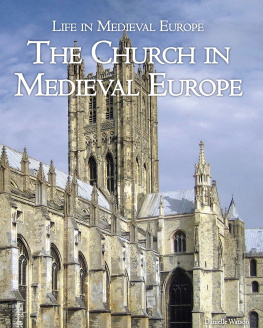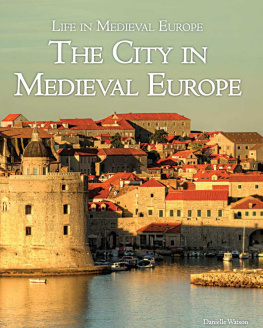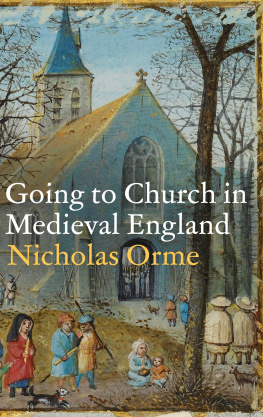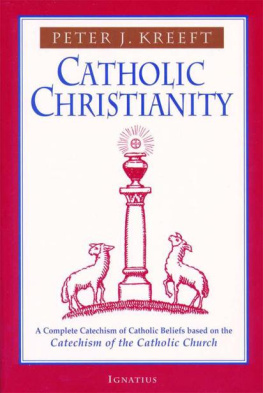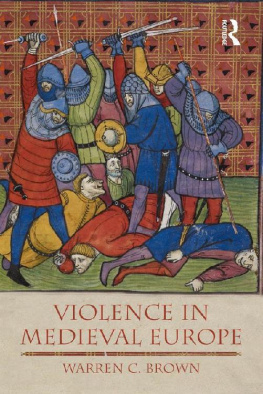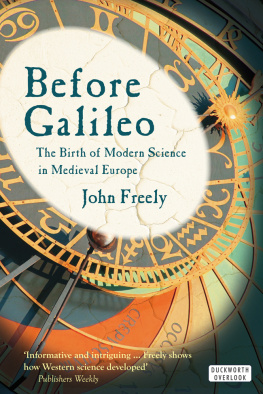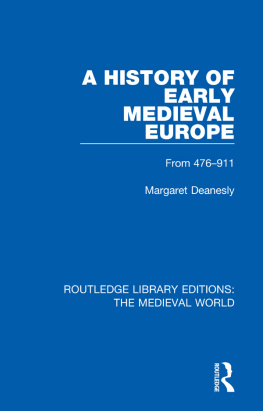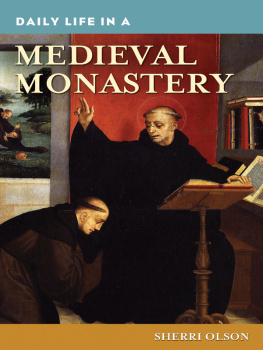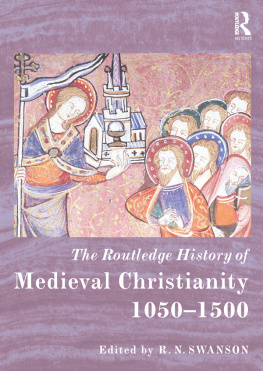Danielle Watson - The Church in Medieval Europe
Here you can read online Danielle Watson - The Church in Medieval Europe full text of the book (entire story) in english for free. Download pdf and epub, get meaning, cover and reviews about this ebook. year: 2017, publisher: Cavendish Square Publishing, LLC, genre: Religion. Description of the work, (preface) as well as reviews are available. Best literature library LitArk.com created for fans of good reading and offers a wide selection of genres:
Romance novel
Science fiction
Adventure
Detective
Science
History
Home and family
Prose
Art
Politics
Computer
Non-fiction
Religion
Business
Children
Humor
Choose a favorite category and find really read worthwhile books. Enjoy immersion in the world of imagination, feel the emotions of the characters or learn something new for yourself, make an fascinating discovery.
- Book:The Church in Medieval Europe
- Author:
- Publisher:Cavendish Square Publishing, LLC
- Genre:
- Year:2017
- Rating:3 / 5
- Favourites:Add to favourites
- Your mark:
- 60
- 1
- 2
- 3
- 4
- 5
The Church in Medieval Europe: summary, description and annotation
We offer to read an annotation, description, summary or preface (depends on what the author of the book "The Church in Medieval Europe" wrote himself). If you haven't found the necessary information about the book — write in the comments, we will try to find it.
The Church in Medieval Europe — read online for free the complete book (whole text) full work
Below is the text of the book, divided by pages. System saving the place of the last page read, allows you to conveniently read the book "The Church in Medieval Europe" online for free, without having to search again every time where you left off. Put a bookmark, and you can go to the page where you finished reading at any time.
Font size:
Interval:
Bookmark:


Published in 2017 by Cavendish Square Publishing, LLC 243 5th Avenue, Suite 136, New York, NY 10016
Copyright 2017 by Cavendish Square Publishing, LLC First Edition
No part of this publication may be reproduced, stored in a retrieval system, or transmitted in any form or by any means electronic, mechanical, photocopying, recording, or otherwisewithout the prior permission of the copyright owner. Request for permission should be addressed to Permissions, Cavendish Square Publishing, 243 5th Avenue, Suite 136, New York, NY 10016.
Tel (877) 980-4450; fax (877) 980-4454.
Website: cavendishsq.com
This publication represents the opinions and views of the author based on his or her personal experience, knowledge, and research. The information in this book serves as a general guide only. The author and publisher have used their best efforts in preparing this book and disclaim liability rising directly or indirectly from the use and application of this book.
CPSIA Compliance Information: Batch #CS16CSQ All websites were available and accurate when this book was sent to press.
Library of Congress Cataloging-in-Publication Data
Names: Watson, Danielle, 1978- author.
Title: The church in medieval Europe / Danielle Watson.
Description: New York : Cavendish Square Publishing, 2016. | Series: Life in medieval Europe |
Includes bibliographical references and index. |
Description based on print version record and CIP data provided by publisher; resource not viewed.
Identifiers: LCCN 2016001610 (print) | LCCN 2016000269 (ebook) |
ISBN 9781502618856 (ebook) | ISBN 9781502618849 (library bound)
Subjects: LCSH: Europe--Church history--600-1500.
Classification: LCC BR750 (print) | LCC BR750 .W37 2016 (ebook) |
DDC 274/.03--dc23
LC record available at http://lccn.loc.gov/2016001610
Editorial Director: David McNamara Editor: Kelly Spence Copy Editor: Nathan Heidelberger Art Director: Jeffrey Talbot Designer: Joseph Macri Production Assistant: Karol Szymczuk Photo Research: J8 Media
The photographs in this book are used by permission and through the courtesy of: Hans Musil/File:Canterbury Cathedral - Portal Nave Cross-spire.jpeg/Wikimedia Commons, cover; Ron Ellis/Shutterstock.com, 4; APIC/Getty Images, 6; Prisma/UIG/Getty Images, 10; De Agostini
Picture Library/A. Dagli Orti/Bridgeman Images, 11; Radu Bercan/Shutterstock.com, 12; GraphicaArtis/Getty Images, 17; John Elk III/ Lonely Planet Images/Getty Images, 18; Alastair Wallace/Shutterstock.com, 21; Lindrik/iStock/Thinkstock.com, 24; Universal History Archive/ UIG via Getty Images, 26; Art Media/Print Collector/Getty Images, 32; Renata Sedmakova/Shutterstock.com, 34; Florilegius/SSPL/Getty Images, 35; Art Media/Print Collector/Getty Images, 36; Tarker/Bridgeman Images, 39; http://wellcomeimages.org/indexplus/obf_images/ f6/21/96b5317994bc34d2cc2ddb38d87b.jpg/File:Engraving; German abbess and physician Hildegard von Bingen Wellcome L0005783.jpg/ Wikimedia Commons, 42; Castres, bibliotheque municipale/File:Philo mediev.jpg/Wikimedia Commons, 46; Musee Conde, Chantilly, France/ Bridgeman Images, 49; David Harris, The Art of Calligraphy, Dorling Kindersley 1995, ISBN 1564588491/File:Book of Hours Bentivoglio.jpg/ Wikimedia Commons, 51; Florilegius/SSPL/Getty Images, 53; DeAgostini/Getty Images, 56; Petrusbarbygere/File:Folio 173v - The Entry into Jerusalem.jpg/Wikimedia Commons, 59; David Gee/File:ChesterMysteryPlay 300dpi.jpg/Wikimedia Commons, 60; Leemage/Bridgeman
Images, 62; Tallandier/Bridgeman Images, 69.
C ontents

T he medieval period, also known as the Middle Ages, spans about one thousand years of European history, between 500 and 1500. The years 1100-1400 made up the High Middle Ages, a period distinguished by a swelling population that led to great social, economic, and political changes across the continent.
The late Middle Ages saw the emergence of humanists, individuals who, during the fourteenth century, took a renewed interest in ancient Roman and Greek literature and ideologies. Humanists believed that the previous ten centuries had been a dark age, with no great human advancements or thinkers. They sought to distance themselves from this time period and to create a rebirth of ancient learning. The rise of humanism led to the period following the Middle Ages, which became known as the Renaissance.
During the Middle Ages, the Catholic Church served as a central unifying power across Europe. From his seat in Rome, the pope oversaw an extensive network of religious figures from nuns to bishops. From small parish churches to soaring cathedrals, the Catholic Church touched the lives of all medieval people.

Charles accordingly went to Rome, to set in order the affairs of the Church, which were in great confusion, and passed the whole winter there. It was then that he received the titles of Emperor and Augustus to which he at first had such an aversion that he declared that he would not have set foot in the Church the day that they were conferred, although it was a great feast-day, if he could have foreseen the design of the Pope.
a description of Charlemagne being crowned emperor on December 25, 800 CE
F or centuries, much of Europe was ruled by the Roman Empire. Under Roman rule and the leadership of Emperor Constantine I, Christianity would become the dominant religion of the medieval world.
In the year 313 ce, Roman rule stretched from Spain to the Middle East, including most of western Europe and all of southern Europe. Throughout the empire, people practiced many different religions, including Christianity. At this time, only about 10 percent of western Europes people were Christians, and Christianity had a much lower status than most other religions. Constantine had been learning a great deal about the new faith, however, and he came to a momentous decision: he would give Christianity equal rights and privileges with other religions. Most of the emperors who came after Constantine were Christians, and they continued to strengthen the church. By the year 400, Christianity was the official religion of the empire.
Beyond the empires boundaries, among the people whom the Romans called barbarians, ancient religions still flourished. The church, however, believed it had a duty to bring all people into the Christian faith. Since Christianitys beginnings, missionaries had traveled far and wide to spread their religion. Now, with the support and protection of the government, the church could send out even more missionaries and spread Christianity even farther.
In the late 400s, the western half of the Roman Empire fell to barbarian invaders. The church remained strong, however, and eventually the invaders converted to Christianity. One Christian descendant of the barbarians was Charles Martel, who turned away a new set of invaders in 732. These were Muslim warriors, who for a hundred years had been spreading their religion, Islam, from its homeland in Arabia. They had conquered North Africa and advanced up through Spain, but Martel stopped them from going farther into Europe. He became a hero to Christian Europe and founded a line of powerful rulers.
Font size:
Interval:
Bookmark:
Similar books «The Church in Medieval Europe»
Look at similar books to The Church in Medieval Europe. We have selected literature similar in name and meaning in the hope of providing readers with more options to find new, interesting, not yet read works.
Discussion, reviews of the book The Church in Medieval Europe and just readers' own opinions. Leave your comments, write what you think about the work, its meaning or the main characters. Specify what exactly you liked and what you didn't like, and why you think so.

